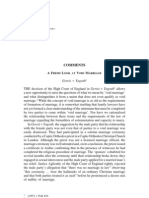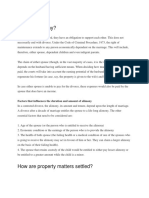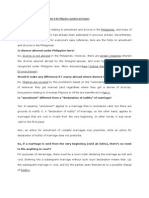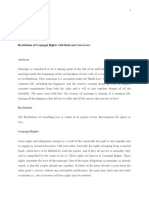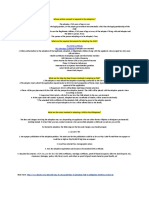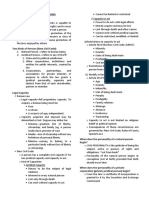0 ratings0% found this document useful (0 votes)
142 viewsCommon Law Marriage in Colorado
Common Law Marriage in Colorado
Uploaded by
Anthony Isidro Bayawa IVColorado recognizes common law marriages where two parties mutually consent to be married and assume a marital relationship without a legal ceremony. To establish a common law marriage, it must be shown that the parties cohabited and held themselves out to the public as husband and wife. General reputation in the community as a married couple creates an inference of consent to marry. While cohabitation alone is not enough, factors like using the same surname, jointly owning property, filing joint taxes, and introducing each other as spouses can help prove the existence of a common law marriage. Once established, a common law marriage can only be terminated through the dissolution process.
Copyright:
© All Rights Reserved
Available Formats
Download as PDF, TXT or read online from Scribd
Common Law Marriage in Colorado
Common Law Marriage in Colorado
Uploaded by
Anthony Isidro Bayawa IV0 ratings0% found this document useful (0 votes)
142 views2 pagesColorado recognizes common law marriages where two parties mutually consent to be married and assume a marital relationship without a legal ceremony. To establish a common law marriage, it must be shown that the parties cohabited and held themselves out to the public as husband and wife. General reputation in the community as a married couple creates an inference of consent to marry. While cohabitation alone is not enough, factors like using the same surname, jointly owning property, filing joint taxes, and introducing each other as spouses can help prove the existence of a common law marriage. Once established, a common law marriage can only be terminated through the dissolution process.
Original Description:
US law in colorado
Original Title
Common Law
Copyright
© © All Rights Reserved
Available Formats
PDF, TXT or read online from Scribd
Share this document
Did you find this document useful?
Is this content inappropriate?
Colorado recognizes common law marriages where two parties mutually consent to be married and assume a marital relationship without a legal ceremony. To establish a common law marriage, it must be shown that the parties cohabited and held themselves out to the public as husband and wife. General reputation in the community as a married couple creates an inference of consent to marry. While cohabitation alone is not enough, factors like using the same surname, jointly owning property, filing joint taxes, and introducing each other as spouses can help prove the existence of a common law marriage. Once established, a common law marriage can only be terminated through the dissolution process.
Copyright:
© All Rights Reserved
Available Formats
Download as PDF, TXT or read online from Scribd
Download as pdf or txt
0 ratings0% found this document useful (0 votes)
142 views2 pagesCommon Law Marriage in Colorado
Common Law Marriage in Colorado
Uploaded by
Anthony Isidro Bayawa IVColorado recognizes common law marriages where two parties mutually consent to be married and assume a marital relationship without a legal ceremony. To establish a common law marriage, it must be shown that the parties cohabited and held themselves out to the public as husband and wife. General reputation in the community as a married couple creates an inference of consent to marry. While cohabitation alone is not enough, factors like using the same surname, jointly owning property, filing joint taxes, and introducing each other as spouses can help prove the existence of a common law marriage. Once established, a common law marriage can only be terminated through the dissolution process.
Copyright:
© All Rights Reserved
Available Formats
Download as PDF, TXT or read online from Scribd
Download as pdf or txt
You are on page 1of 2
Common Law Marriage in Colorado
"Am I or am I not married?"
The concept of common law marriage has been recognized for many years in Colorado.
Essentially, in a common law marriage, two parties create a valid marital relationship without the
benefit of a legal marriage ceremony performed according to the statutory requirements of
C.R.S. 14-2-106. The foundation for a common law marriage is mutual consent or agreement
of the parties to be husband and wife, and thereafter a mutual and open assumption of a marital
relationship.
There are many misconceptions about the requirements for a valid common law marriage. A
present contract of marriage must exist to create a relationship of husband and wife. An
agreement to marry in the future does not create a common law marriage. Frequently, a problem
arises after the breakup of two people who have been living together and one party claims they
have a common law marriage. In other situations, a death, injury or disability may occur,
creating problems for the alleged common law spouse.
This article discusses the requirements for establishing a common law marriage in Colorado.
ELEMENTS OF PROOF
COHABITATION AND REPUTATION
In establishing the existence of a common law marriage, it is difficult to prove that an actual
contract or agreement to marry existed between the parties. Colorado does not require a fixed
period of time of cohabitation to establish common law marriage. However, evidence of
cohabitation and reputation as husband and wife generally will constitute proof of a common law
marriage. While cohabitation and reputation as a married couple are not essential elements of a
common law marriage, they create an inference that the parties have consented to a marriage
contract.
The parties must cohabit as husband and wife and claim to be such. However, cohabitation alone
is not sufficient to establish common law marriage; they must do more than merely live together
in the same house. In order for a presumption of marriage to arise, the parties must intend to be
married as evidenced by their conduct and general reputation. General reputation as a husband
and wife includes social conduct and recognition giving character to a martial relationship,
understanding among neighbors and acquaintances that they are living together as husband and
wife, and other attendant circumstances which would provide recognition of the parties as
husband and wife.
If one party believes that the parties are living as husband and wife but the other party does not
and there is not other affirmative conduct as husband and wife, there cannot be a common law
marriage. The parties essentially must act, perform and do everything as if they were married
but without a valid Colorado ceremony. Further, a common law marriage cannot exist while one
party is still married to a third party.
OTHER ELEMENTS OF PROOF
The existence of a common law marriage may be shown by facts other that general reputation.
Where a woman has taken the surname of the man with whom she cohabits, the courts have
found a general reputation necessary to imply a contract of marriage. The fact that a woman
continues to use her maiden name after a purported common law marriage may negate a general
reputation of the parties as husband and wife. If no contrary evidence is presented to refute an
inference of marriage by cohabitation and repute, a claim of common law marriage may be
sustained.
Situations may exist where one party mistakenly believes he or she is available to enter into a
common law marriage but is legally prohibited from doing so because of a legal impediment
such as an invalid prior divorce. Where the two parties in good faith agree to become husband
and wife, hold themselves out as such and, in good faith, mistakenly believe neither is married,
the intended marriage will be effective the moment the legal disability to marry no longer exists.
Removal of a disability to be married may also create a common law marriage where the parties
to an illicit relationship consent to be married and evidence of cohabitation and repute as
husband and wife is established after the disability is removed.
Common law marriages also have been found to exist where previously married and divorced
spouses subsequently cohabit as husband and wife. A lesser degree of proof may be required in
this instance.
Some factors that might be considered proof of the existence of a common law marriage include
the following:
1. introduction of each other to neighbors, friends, acquaintances or business partners as
husband and wife;
2. cohabitation of the parties as husband and wife;
3. maintenance of joint accounts;
4. purchase and joint ownership of property;
5. mutual financial support of each other;
6. registration as husband and wife on applications, leases, contract forms and hotel registers;
7. use of the mans surname by the woman; and
8. filing of joint tax returns.
CONCLUSION
Once a common law marriage is established, to terminate the relationship the parties must
conform to the requirements of the Uniform Dissolution of Marriage Act in Colorado. In
addition, the benefits received by one party as the legal spouse of another must also be applied
without discrimination to a common law spouse. Therefore, practitioners should advise clients
that when parties do not intend for a marriage to exist, they should clearly make such
information known to the general public. Counsel also may want to recommend that the parties
sign a cohabitation agreement.
You might also like
- Co-Parenting 101Document225 pagesCo-Parenting 101Aziz RahmanNo ratings yet
- Common Law MarriageDocument9 pagesCommon Law MarriageJP Maxwell100% (4)
- I. Introduction To MarriageDocument28 pagesI. Introduction To MarriageTokie Toki0% (1)
- PVL2601 Study NotesDocument24 pagesPVL2601 Study Notesmmeiring1234100% (6)
- What Is Marriage?: A Marriage Could Also Be Declared VoidDocument2 pagesWhat Is Marriage?: A Marriage Could Also Be Declared VoidPriya AroraNo ratings yet
- Annulment, Divorce and Legal SeparationDocument12 pagesAnnulment, Divorce and Legal SeparationPrecious Rain GloryNo ratings yet
- Group 7 Family Law.Document9 pagesGroup 7 Family Law.Ibidun TobiNo ratings yet
- Family LawDocument54 pagesFamily Lawluciana gomezNo ratings yet
- Gale Researcher Guide for: Patterns of Intimate Partnership TerminationFrom EverandGale Researcher Guide for: Patterns of Intimate Partnership TerminationNo ratings yet
- Circumstantial Evidence Enough To Prove Adultery: AnswerDocument6 pagesCircumstantial Evidence Enough To Prove Adultery: AnswerRodolfo CorpuzNo ratings yet
- Department of Law & CLE & Professional Advisor, LDC) : LecturerDocument6 pagesDepartment of Law & CLE & Professional Advisor, LDC) : LecturerRose KasujjaNo ratings yet
- Report On Civil Registry of The PhilippinesMarriageAnnulmentAdoptionDocument9 pagesReport On Civil Registry of The PhilippinesMarriageAnnulmentAdoptionAdrianNo ratings yet
- Comments: A F L V MDocument5 pagesComments: A F L V MJy FooNo ratings yet
- Family Law 1Document61 pagesFamily Law 1Mpaulo ReaganNo ratings yet
- void marriages internal 230403 134928Document4 pagesvoid marriages internal 230403 134928roxanne.coopooNo ratings yet
- Annulment vs. Divorce: What's The Difference?Document2 pagesAnnulment vs. Divorce: What's The Difference?nizNo ratings yet
- Legal Separation in The Philippine SettingDocument10 pagesLegal Separation in The Philippine SettingRegina Via G. GarciaNo ratings yet
- Signal 2024 12 01 141937Document8 pagesSignal 2024 12 01 141937adeyemikazeem012No ratings yet
- Bigamy DefenseDocument3 pagesBigamy DefenseAurora Saralde MatienzoNo ratings yet
- Person's - WikipediaDocument2 pagesPerson's - WikipediaaileenairaNo ratings yet
- Substantive Law Family Law, Wills, Trusts, Probate and Real EstateDocument7 pagesSubstantive Law Family Law, Wills, Trusts, Probate and Real EstateButaneko0003No ratings yet
- What Is Alimony?: Factors That Influences The Duration and Amount of AlimonyDocument4 pagesWhat Is Alimony?: Factors That Influences The Duration and Amount of AlimonykrithikaNo ratings yet
- AnnulmentDocument7 pagesAnnulmentR-ny Odimogra AsgamudNo ratings yet
- Faimly LawDocument17 pagesFaimly Lawm84801754No ratings yet
- Relative Divorce (Reaction Paper)Document4 pagesRelative Divorce (Reaction Paper)Jonil Canino100% (1)
- Promise To Marry FINALDocument7 pagesPromise To Marry FINALSAMUKA HERMANNo ratings yet
- Divorce vs AnullmentDocument8 pagesDivorce vs Anullmentfemale.dog20500No ratings yet
- Family LawDocument80 pagesFamily LawYusuf AhmedNo ratings yet
- Material de Clase - Lecto - Derecho de Familia - 2023Document12 pagesMaterial de Clase - Lecto - Derecho de Familia - 2023ErwinNo ratings yet
- Divorce Is Not Allowed Certain Instances Former Filipinos Here Judicial Recognition of A Foreign Divorce DecreeDocument12 pagesDivorce Is Not Allowed Certain Instances Former Filipinos Here Judicial Recognition of A Foreign Divorce DecreeAlexis AguinaldoNo ratings yet
- Alcana, Kyla g. (Module 2 in Lrs)Document6 pagesAlcana, Kyla g. (Module 2 in Lrs)Kyla Gomez AlcanaNo ratings yet
- Group 6 - Statutory Marriage - 1Document12 pagesGroup 6 - Statutory Marriage - 1Ibidun TobiNo ratings yet
- FAMILY Law PackDocument166 pagesFAMILY Law PackAyanda100% (2)
- FAMILY LAW - Handout 1Document4 pagesFAMILY LAW - Handout 1marek.hospiNo ratings yet
- Civil Code NotesDocument62 pagesCivil Code Notesariel lapiraNo ratings yet
- UNIT 5 Invariable Consequences of Marriage - Part 1Document8 pagesUNIT 5 Invariable Consequences of Marriage - Part 1mmamosaellenNo ratings yet
- AnnulmentDocument13 pagesAnnulmentrockaholicnepsNo ratings yet
- AnnulmentDocument27 pagesAnnulmentoxy28100% (1)
- Annulment, Divorce and Legal Separation in The PhilsDocument5 pagesAnnulment, Divorce and Legal Separation in The PhilsJocelyn HerreraNo ratings yet
- PersonsDocument23 pagesPersonsharitha kusalNo ratings yet
- Registration Ordinance of 1907. This Ordinance Applies To Marriages Tamils, and PersonsDocument6 pagesRegistration Ordinance of 1907. This Ordinance Applies To Marriages Tamils, and PersonsDisura Perera100% (1)
- Law of Partnership StudyDocument16 pagesLaw of Partnership StudyNene onetwoNo ratings yet
- Module 2Document32 pagesModule 2Andrew Belgica100% (1)
- Common LawDocument5 pagesCommon LawsquidblitzNo ratings yet
- On Family Law and CohabitationDocument7 pagesOn Family Law and CohabitationArindomNo ratings yet
- DowerDocument12 pagesDowerChitralekha MishraNo ratings yet
- Family LawDocument10 pagesFamily LawmhiityyNo ratings yet
- AnnulmentDocument4 pagesAnnulmentrichardNo ratings yet
- Contract For LoveDocument4 pagesContract For Lovelindy6614444100% (1)
- Annulment, Divorce and Legal Separation in The PhilippinesDocument15 pagesAnnulment, Divorce and Legal Separation in The PhilippinesSerene SantosNo ratings yet
- Study Unit 2 Void, Voidable and Putative Marriage-Summary NotesDocument5 pagesStudy Unit 2 Void, Voidable and Putative Marriage-Summary NotesAsenathi SandisoNo ratings yet
- LLB Family Law HinduDocument51 pagesLLB Family Law HinduShri LathaNo ratings yet
- Requisites of MarriageDocument13 pagesRequisites of MarriageDynli CharmNo ratings yet
- Annulment and Legal Separation in The PhilippinesDocument3 pagesAnnulment and Legal Separation in The PhilippinesJayson Arvene MondragonNo ratings yet
- Medico-Legal Aspects of Marital Union and DissolutionDocument9 pagesMedico-Legal Aspects of Marital Union and DissolutionRen Chan TanNo ratings yet
- Thoughts On The Divorce Bill of Gabriela WomenDocument6 pagesThoughts On The Divorce Bill of Gabriela WomenLisa Marie J. ClementeNo ratings yet
- Blog 1Document3 pagesBlog 1Keshar TanwarNo ratings yet
- Family Law Course NotesDocument18 pagesFamily Law Course NotesBoris GeraldNo ratings yet
- Void Marriages in The Philippines: Its Features and ConsequencesDocument21 pagesVoid Marriages in The Philippines: Its Features and ConsequencesClaire PaloNo ratings yet
- LLB - FAMILY LAW - Revision Notes - Units 1 To 5Document32 pagesLLB - FAMILY LAW - Revision Notes - Units 1 To 5Nicholas19No ratings yet
- PFR Marriage Case DoctrinesDocument7 pagesPFR Marriage Case DoctrinesBoletPascuaNo ratings yet
- Uprrn1E Q (:ourt: L Epubhr Ot TijeDocument10 pagesUprrn1E Q (:ourt: L Epubhr Ot TijeAnthony Isidro Bayawa IVNo ratings yet
- Court Administrator Vs Atty. ToledoDocument18 pagesCourt Administrator Vs Atty. ToledoAnthony Isidro Bayawa IVNo ratings yet
- Upreme QI:ourt: 3r.epublic of Tbe FlbilippinesDocument24 pagesUpreme QI:ourt: 3r.epublic of Tbe FlbilippinesAnthony Isidro Bayawa IVNo ratings yet
- L/epubltc of Tbe btltpptneii'ME Upreme Ql:ourt:fflantla: First DivisionDocument26 pagesL/epubltc of Tbe btltpptneii'ME Upreme Ql:ourt:fflantla: First DivisionAnthony Isidro Bayawa IVNo ratings yet
- Ampatuan Vs Secretary of JusticeDocument23 pagesAmpatuan Vs Secretary of JusticeAnthony Isidro Bayawa IVNo ratings yet
- SASHA M. CABRERA, Petitioner vs. THE PHILIPPINE STATISTICS AUTHORITY 2019Document6 pagesSASHA M. CABRERA, Petitioner vs. THE PHILIPPINE STATISTICS AUTHORITY 2019Anthony Isidro Bayawa IVNo ratings yet
- Division: TH RDDocument19 pagesDivision: TH RDAnthony Isidro Bayawa IVNo ratings yet
- Rpubltc of TBR Btlipptnr, G Q (Ourt: Third Division Rita Quizon-Arciga and G.R. No. 256612 Relia Q. ArcigaDocument12 pagesRpubltc of TBR Btlipptnr, G Q (Ourt: Third Division Rita Quizon-Arciga and G.R. No. 256612 Relia Q. ArcigaAnthony Isidro Bayawa IVNo ratings yet
- Anti-Terrorism LawDocument124 pagesAnti-Terrorism LawAnthony Isidro Bayawa IVNo ratings yet
- Upreme Qcourt: 31/cpublir of Tbe BilippinesDocument38 pagesUpreme Qcourt: 31/cpublir of Tbe BilippinesAnthony Isidro Bayawa IVNo ratings yet
- Epublic of Tbe Ilbilippines: !courtDocument20 pagesEpublic of Tbe Ilbilippines: !courtAnthony Isidro Bayawa IVNo ratings yet
- Excerpts of Recent 2021 DecisionsDocument13 pagesExcerpts of Recent 2021 DecisionsAnthony Isidro Bayawa IVNo ratings yet
- 91 PDFDocument34 pages91 PDFAnthony Isidro Bayawa IVNo ratings yet
- 2021 DecisionsDocument57 pages2021 DecisionsAnthony Isidro Bayawa IVNo ratings yet
- The Diocese of Bacolod VS ComelecDocument11 pagesThe Diocese of Bacolod VS ComelecAnthony Isidro Bayawa IVNo ratings yet
- Napoles Vs de Lima 2016Document16 pagesNapoles Vs de Lima 2016Anthony Isidro Bayawa IVNo ratings yet
- Djumantan CaseDocument1 pageDjumantan CaseAnthony Isidro Bayawa IVNo ratings yet
- KLM Vs MendozaDocument2 pagesKLM Vs MendozaAnthony Isidro Bayawa IVNo ratings yet
- Worksheets FamilyDocument4 pagesWorksheets FamilyGomezcarraga RoNo ratings yet
- Family TherapyDocument29 pagesFamily TherapyAnnPSW100% (1)
- Domestic AdoptionDocument2 pagesDomestic AdoptionKarla EspinosaNo ratings yet
- Transformative Motherhood: On Giving and Getting in A Consumer CultureDocument3 pagesTransformative Motherhood: On Giving and Getting in A Consumer CulturePaloma CastroNo ratings yet
- UNIT 1Document9 pagesUNIT 1Bùi Anh DươngNo ratings yet
- Shashwat Family LawDocument19 pagesShashwat Family LawShashwat PathakNo ratings yet
- A To Z - WritingDocument52 pagesA To Z - Writingapi-3740569100% (3)
- Blood Relation 2Document1 pageBlood Relation 2Aswathy KNo ratings yet
- Divorce Position PaperDocument22 pagesDivorce Position PaperSherla Najera79% (19)
- English CollocationDocument3 pagesEnglish CollocationKhoi NguyenNo ratings yet
- Carlos Vs SandovalDocument1 pageCarlos Vs SandovalGretchenNo ratings yet
- New JerseyDocument13 pagesNew JerseyDeep PadhNo ratings yet
- Module 9 Blood RelationDocument24 pagesModule 9 Blood RelationRaunak PalewarNo ratings yet
- Hindu Law End TermDocument18 pagesHindu Law End TermVibhu TeotiaNo ratings yet
- Arts. 74 To 87 Family Code NotesDocument4 pagesArts. 74 To 87 Family Code NotesMarinelle Aycee Moleta Perral100% (1)
- Notes On Persons, Concept & Nature of Marriage, and FamilyDocument7 pagesNotes On Persons, Concept & Nature of Marriage, and FamilymmaNo ratings yet
- 부산관광지도영문Document2 pages부산관광지도영문Gopinath KrishnamoorthyNo ratings yet
- Intestate TableDocument4 pagesIntestate TablechikayNo ratings yet
- Child Protective Services - WikipediaDocument1 pageChild Protective Services - WikipediaBadhon Chandra SarkarNo ratings yet
- Notes in PFRDocument28 pagesNotes in PFRChaNo ratings yet
- Logical Reasoning: 1. Logical Reasoning Ability Test: Analytical-Reasoning QUESTIONS AND ANSWERS:: Part1: 1 To 5Document16 pagesLogical Reasoning: 1. Logical Reasoning Ability Test: Analytical-Reasoning QUESTIONS AND ANSWERS:: Part1: 1 To 5keshav181No ratings yet
- đề cương toán 3Document4 pagesđề cương toán 3Nguyễn NgọcNo ratings yet
- Annulment - Felicilda (Group 1)Document12 pagesAnnulment - Felicilda (Group 1)Ms.PoppyNo ratings yet
- List of Approved Hotels Guest Houses in Bangladesh (31 Jan 2021)Document12 pagesList of Approved Hotels Guest Houses in Bangladesh (31 Jan 2021)Mitela Rahman100% (2)
- A Family Members Quiz PresentationDocument24 pagesA Family Members Quiz PresentationSaiza JeonNo ratings yet
- Thesis Paper AssignmentDocument6 pagesThesis Paper AssignmentthebeautyinsideNo ratings yet
- Guide For New DadsDocument12 pagesGuide For New Dadscuntmaster1100% (1)
- Adopting Divorce in The Family CodeDocument3 pagesAdopting Divorce in The Family CodeCherrylNo ratings yet
- Surrogacy: Name: Roll NoDocument14 pagesSurrogacy: Name: Roll NoShikhaNo ratings yet












